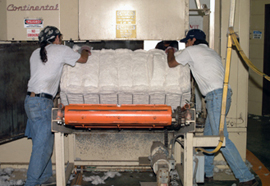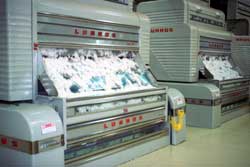Major activities carried out during 2002.

Prior to the 2002 season, producers were urged to comply with insect resistance management provisions for Bt cotton varieties, specifically the use of refugia. This was deemed crucial as cotton producers planted 71 percent of their acreage to biotech varieties in 2002. The NCC’s studies confirmed university research that showed fiber quality degradation was not related to genetic engineering, and continued to work to ensure that government approvals would maintain public confidence for biotech products.
 |
Fiber spinning efficiency and overall lint value were among issues addressed by |
 |
Through the efforts of the NCC Quality Task Force, chaired by Jimmy Sanford, economic signals were sent to growers that were consistent with important factors determining fiber spinning efficiency and overall lint value.
The Task Force continued to address a range of quality issues from pepper trash to short fiber. It adopted a recommendation calling for the USDA-Agriculture Marketing Service (AMS) Cotton Program to continue collecting data on market discounts applied to the Southeast and Mid-South cotton in the 4.8 to 4.9 micronaire range.
The Joint Cotton Industry Bale Packaging Committee, chaired by Keith Pendergrass, also focused on fiber quality preservation and the efficient movement of fiber after ginning. That panel called for a review of the specifications for all bale packaging and ties to ensure they meet industry needs. Chairman Hood also appointed a special panel to address the concern of lightweight bales, which resulted in an industry consensus for bale weight penalties.
Included in efforts to improve cotton flow was the NCC’s coordination with USDA-AMS in urging gins and warehouses not to reuse Permanent Bale Identification numbers.
 |
All bale tie and packaging specifications were reviewed as a recommendation of the Joint Cotton Industry Bale Packaging Committee. |
Boll weevil eradication gained momentum, producers in four eradication zones in Texas reaffirming their commitment. With complete eradication in the U.S. within reach by 2005, Boll Weevil Action Committee Chairman Charles Parker appointed a committee to formulate guidelines for transition from active eradication to post eradication activities. The Committee also urged the APHIS to accelerate rulemaking to get a federal quarantine for boll weevil completed by the end of 2004.
Significant progress made in the Bi-National Pink Bollworm Eradication Program’s first phase in West Texas, South Central New Mexico and the Chihuahua state in Mexico positioned that area to use releases of sterile pink bollworm moths in the 2003 season. The NCC, with support of NCC’s Pink Bollworm Action Committee chaired by William Lovelady, requested an increase in federal funds for the program to offset the cost of sterile insects.
The NCC worked closely with EPA and AmVac on a comprehensive benefits document in support of the continued use of Bidrin, which is effective against resistant populations of plant bugs and stink bugs – insects that have emerged as primary cotton pests. EPA also agreed to retain endosulfan for cotton usage in Texas, Oklahoma, New Mexico, California and Arizona, where it is used on about 60 percent of acres to control whitefly.
U.S. cotton suffered a setback when the U.S. Court of Appeals rejected industry challenges to EPA’s stricter air quality standards for particulate matter and ozone. However, OSHA issued a memo reiterating its position that cotton ginning is an agricultural operation and not a general industry operation. A proposed EPA rule on spray drift also was delayed.
 |
Ginning operations were spared undue regulations when OSHA reiterated its position that ginning is an agricultural, |
The children’s sleepwear issue was raised again when Senators John Breaux (D-LA) and Conrad Burns (R-MT) introduced the Children’s Safe Sleepwear and Burn Prevention Act of 2002. That act sought to remove the 1996 amendments to the Children’s Sleepwear Flammability Standards for sizes 0 to 14 within 180 days. Another bill introduced in the House was similar, but also covered diapers and underwear.
The Consumer Products Safety Commission also issued a notice of proposed rulemaking for a revised standard for the flammability of clothing textiles. This opened up the possibility for making the standard more severe, which could result in some cotton textiles being removed from the market and require some cotton textiles to be treated with fire retardants.
EPA extended the existing temporary exemption from tolerance for Aspergillus flavus AF36 to December 30, 2004. AF36 is the microbial pesticide being used in promising research to eliminate aflatoxin in Arizona and Texas.

